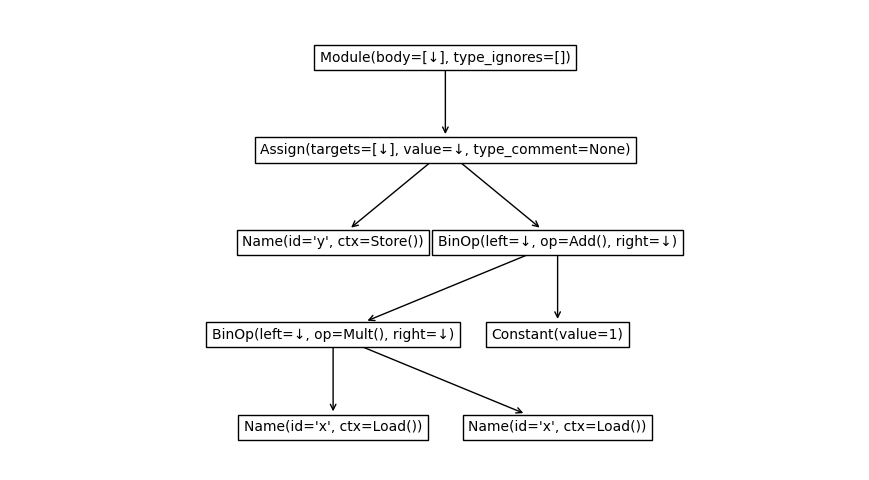This Python package contains a few abstract base classes for tree data structures. Trees are very common data structure that represents a hierarchy of common nodes. This package defines abstract base classes for these data structure in order to make code reusable.
from abstracttree import to_mermaid
to_mermaid(AbstractTree)graph TD;
AbstractTree[AbstractTree];
UpTree[UpTree];
Tree[Tree];
MutableTree[MutableTree];
DownTree[DownTree];
Tree[Tree];
MutableTree[MutableTree];
MutableDownTree[MutableDownTree];
MutableTree[MutableTree];
BinaryDownTree[BinaryDownTree]
BinaryTree[BinaryTree]
AbstractTree-->UpTree;
UpTree-->Tree;
Tree-->MutableTree;
AbstractTree-->DownTree;
DownTree-->Tree;
DownTree-->MutableDownTree;
MutableDownTree-->MutableTree;
DownTree-->BinaryDownTree
BinaryDownTree-->BinaryTree
Tree-->BinaryTree
Downtrees are trees that have links to their direct children. Uptrees are trees that link to their parent. A Tree has links in both directions.
| ABC | Inherits from | Abstract Methods | Mixin Methods |
|---|---|---|---|
AbstractTree |
nid, eqv() |
||
UpTree |
AbstractTree |
parent |
root, is_root, ancestors, path |
DownTree |
AbstractTree |
children |
nodes, descendants, leaves, levels, is_leaf, transform(), nodes.preorder(), nodes.postorder(), nodes.levelorder() |
Tree |
UpTree, DownTree |
siblings |
|
MutableDownTree |
DownTree |
add_child(), remove_child() |
add_children() |
MutableTree |
Tree, MutableDownTree |
detach() |
|
BinaryDownTree |
DownTree |
left_child, right_child |
children, nodes.inorder(), descendants.inorder() |
BinaryTree |
BinaryDownTree, Tree |
In your own code, you can inherit from these trees. For example, if your tree only has links to children:
import abstracttree
from abstracttree import print_tree
class MyTree(abstracttree.DownTree):
def __init__(self, value, children=()):
self.value = value
self._children = children
def __str__(self):
return "MyTree " + str(self.value)
@property
def children(self):
return self._children
tree = MyTree(1, children=[MyTree(2), MyTree(3)])
print_tree(tree)
# This generates the following output:
# MyTree 1
# ├─ MyTree 2
# └─ MyTree 3In practice, not all existing tree data structures implement one of these abstract classes.
As a bridge, you can use astree to convert these trees to a Tree instance.
However, whenever possible, it's recommended to inherit from Tree directly for minimal overhead.
Examples:
# Trees from built-ins and standard library
astree(int)
astree(ast.parse("1 + 1 == 2"))
astree(pathlib.Path("abstracttree"))
# Anything that has parent and children attributes (anytree / bigtree / littletree)
astree(anytree.Node())
# Nested list
astree([[1, 2, 3], [4, 5, 6]])
# Tree from json-data
data = {"name": "a",
"children": [
{"name": "b", "children": []},
{"name": "c", "children": []}
]}
astree(data, children=operator.itemgetter["children"])
# pyqt.QtWidget
astree(widget, children=lambda w: w.children(), parent = lambda w: w.parent())
# Tree from treelib
astree(tree.root, children=lambda nid: tree.children(nid), parent=lambda nid: tree.parent(nid))
# itertree
astree(tree, children=iter, parent=lambda t: t.parent)
# Infinite binary tree
inf_binary = astree(0, children=lambda n: (2*n + 1, 2*n + 2))Pretty printing
tree = astree(seq, children=lambda x: [x[:-2], x[1:]] if x else [])
print_tree(tree)
print(to_string(tree))
# ['a', 'b', 'c', 'd']
# ├─ ['a', 'b']
# │ └─ ['b']
# └─ ['b', 'c', 'd']
# ├─ ['b']
# └─ ['c', 'd']
# └─ ['d']Plotting with matplotlib
import matplotlib.pyplot as plt
expr = ast.parse("y = x*x + 1")
plot_tree(expr)
plt.show()Export to various formats
to_dot(tree)
to_mermaid(tree)
to_latex(tree)
to_image(Path('.'), "filetree.png", how="dot")
to_image(AbstractTree, "class_hierarchy.svg", how="mermaid")
to_pillow(tree).show()import heapq
from abstracttree import HeapTree, Route
tree = HeapTree([5, 4, 3, 2, 1])
heapq.heapify(tree.heap)
left_child = tree.children[0]
right_child = tree.children[1]
route = Route(left_child, right_child)
print(f"{route.lca = }") # => HeapTree([1, 2, 3, 5, 4], 0)
print(f"{route.nodes.count() = }") # => 3
print(f"{route.edges.count() = }") # => 2- PrettyPrintTree - colored terminal output
